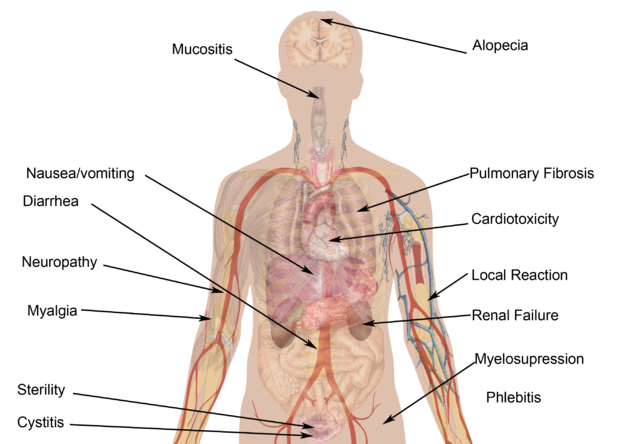Difference Between Radiation and Chemotherapy
Radiation vs Chemotherapy
The Difference between Chemotherapy and Radiation Therapy

Side Effects Of Chemotherapy
Cancer is still one of the leading causes of the death or mortality. According to the World Health Organization (WHO), there are over 100 different kinds of cancer and 30% of these are actually preventable by living a healthy lifestyle and proper or timely immunization. It is also a disease that does not discriminate. It affects people from all walks of life – young or old, rich or poor, male or women. It is a tremendous burden not just for the patients, themselves, but also for their friends and family and generally the people around them.
Scientific research has been going through great lengths to find a cure for cancer. Without a definitive cure, palliative care can be given to those afflicted with the disease in order to at least in one way or another alleviate their pain and suffering. Two of the most common ways to treat cancer that most oncologists recommend are Chemotherapy and Radiation Therapy. Let us try to differentiate them from each other.
Chemotherapy vs. Radiation Therapy
|
Chemotherapy |
Radiation Therapy |
|
| Definition | Refers to the use of drugs or chemicals to slow or stop the growth of cancer cells. | Refers to the use of high-energy radiation to shrink tumors and kill cancer cells. |
| Method | Cytotoxic anti-neoplastic drugs | X-rays, gamma rays, and charged particles are types of radiation used for cancer treatment. |
| How is it administered? |
The chemotherapy is given by a shot in a muscle in your arm, thigh, or hip or right under the skin in the fatty part of your arm, leg, or belly.
The chemotherapy goes directly into the artery that is feeding the cancer.
The chemotherapy goes directly into the peritoneal cavity (the area that contains organs such as your intestines, stomach, liver, and ovaries).
The chemotherapy goes directly into a vein.
The chemotherapy comes in a cream that you rub onto your skin.
The chemotherapy comes in pills, capsules, or liquids that you swallow. |
|
| When is it given? |
Chemotherapy given before surgery or radiotherapy to shrink the tumor.
Chemotherapy used to help destroy any cancer cells that may remain after surgery or radiotherapy. The aim is to reduce the likelihood of cancer returning in the future.
Chemotherapy given both before and after surgery.
Chemotherapy combined with radiotherapy.
If the cancer has spread to other parts of the body, the chemotherapy drugs carried in your bloodstream can reach these cancer cells. The aim is to help relieve symptoms and slow the growth of the cancer. |
|
| Side Effects | The side effects of Chemotherapy depend on the type of drug used, the dosage, and a child’s overall health. These effects are more likely to affect the whole body.
* Medications are available to prevent or alleviate a lot of these symptoms |
Radiation Therapy side effects tend to be more limited to the area that is being treated. However, they do still depend on the dose of radiation given, the location on the body, and whether the radiation was internal or external.
*In addition to the general side effects described above, some side effects of radiation therapy depend on where the radiation is given.
Radiation therapy to the pelvis can also affect the reproductive system. Some women receiving high doses of radiation therapy may stop menstruating and experience symptoms of menopause, such as vaginal itching, burning, and dryness. Permanent infertility (the inability to conceive a child or maintain a pregnancy) can occur, but generally only if both ovaries receive radiation. Men receiving radiation therapy to the testes or to nearby organs, such as the prostate, will have lower sperm counts and reduced sperm activity, which affects fertility. |
Both methods are used in the treatment of cancer and both can cause systemic side effects. They are either given separately or in conjunction with each other depending on the type and severity of the disease. It is still best to consult your doctor and do a full body work up to see what methods works best and decide on the course of action.
- The Difference between Pemphigus and Pemphigoid - July 9, 2015
- The Difference between Flu and Influenza - July 9, 2015
- The Difference Between a Wound and an Ulcer - June 22, 2015
Search DifferenceBetween.net :
1 Comment
Leave a Response
References :
[0]http://www.cancer.gov/about-cancer/treatment/types/radiation-therapy/radiation-fact-sheet
[1]https://commons.wikimedia.org/wiki/File:Side_Effects_of_Chemotherapy.png

Many of the facts in this article are blatantly misleading is not down right false.
1.) Cancer is not solely based upon lifestyle, heredity plays a role as well.
2.) Radiation is not administered 100% outside the body, there are forms that are administered directly during surgical intervention, such as special Gamma Knife procedures, Brachytherapy – the placement of radioactive pellets being implanted in the body; such as for prostrate cancer.
3.) Chemotherapy is not normally administered in the patients home, unless specialized medical professionals, with the proper equipment are present at all times.
Please get your facts straight before posting something as useless and misleading regarding Chemotherapy and radiation therapy on your site.